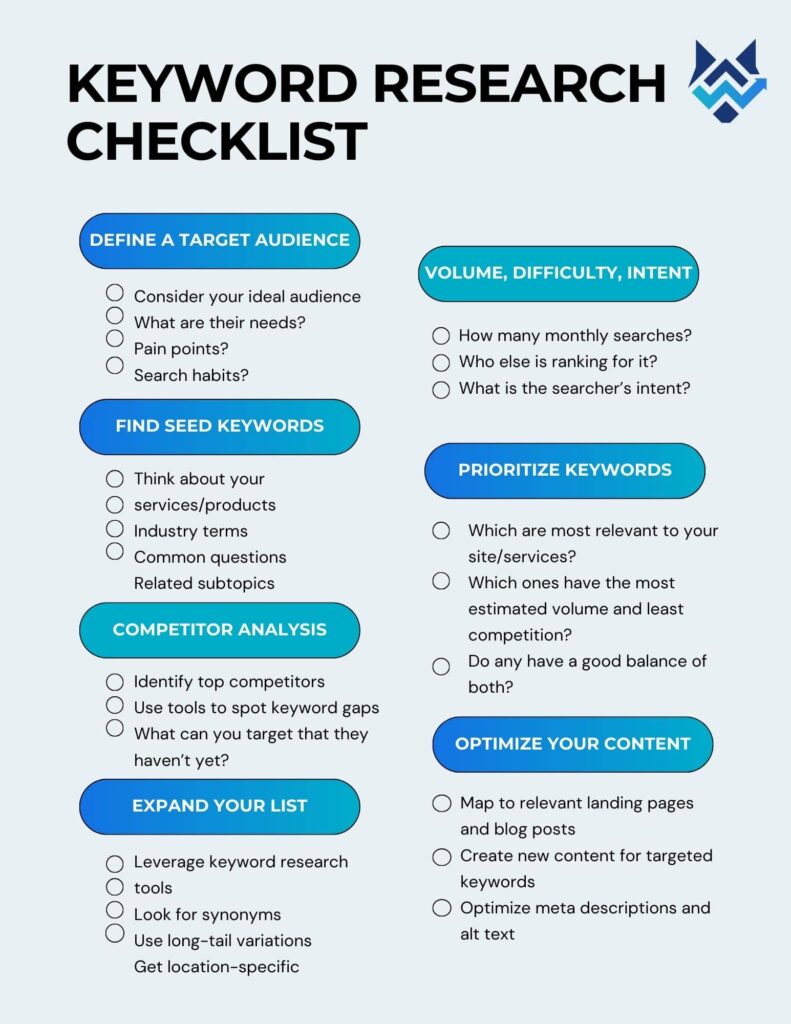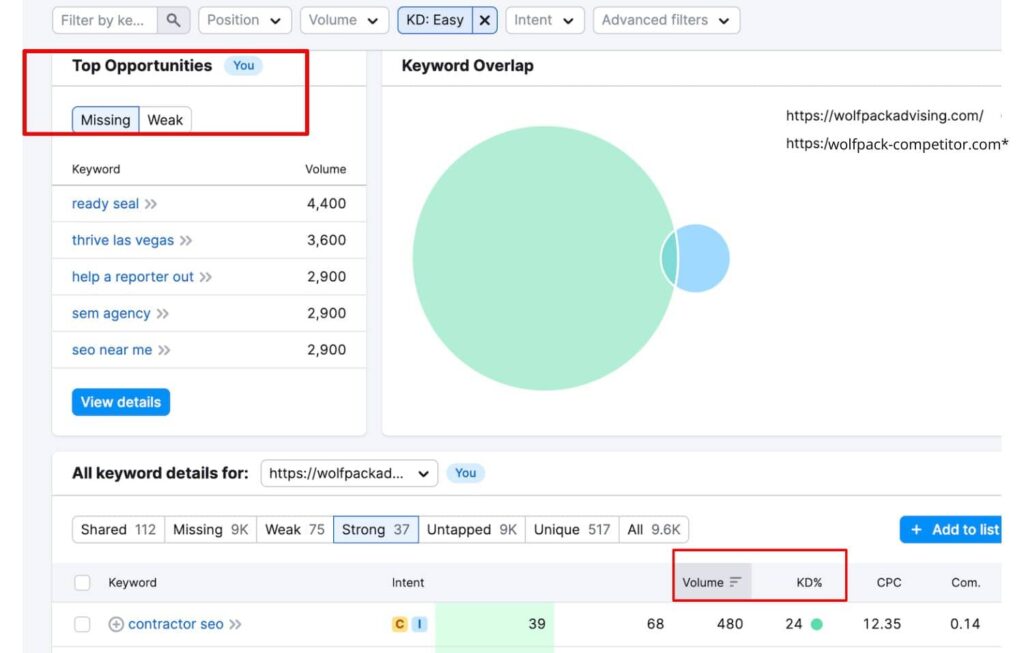Solid keyword research is a pillar of any SEO or marketing strategy. Without it, you risk creating content that’s irrelevant or boring to your audience. So, to give you a leg-up on your keyword research, we’ve developed this checklist breaking down the essential steps.
A streamlined procedure for your keyword research can help you find the most valuable opportunities to reach your customers and create more of what drives engagement.
Here’s what we’ll be covering:
- Defining your target audience
- Generating seed keywords
- Competitor analysis
- Expanding your list
- Assessing search volume, competitiveness, and intent
- Prioritizing keywords
- Implementing your list
The Core of Keyword Research
Keyword research is the process of identifying the words and phrases your target audience uses when searching for topics related to your business.
It’s kind of the backbone of your SEO, as it lets you peek into the search habits of your audience and create content that resonates with them. The goal of keyword research is to find relevant or trending terms that would drive targeted traffic to your website. You’ll need to consider factors such as the estimated search volume, keyword difficulty, and search intent – don’t worry, we’ll cover all of this.
To summarize, the aim is to tailor content to your market, their pain points, and their typical behavior online. In turn, the relevance and value your site provides will boost your visibility, helping you attract more qualified leads and conversions.

Essential Keyword Research Checklist
Ready to dive in? This checklist is designed to help you identify the most valuable keyword opportunities without pulling your hair out or killing an entire day doing research. Once you get confident, you can tweak and add list items according to your specific business needs.
1) Define Your Target Audience
Firstly, identify your ideal customer. Specifically, create buyer personas that outline their demographics, interests, pain points, and goals. This will help you understand the language they use and the topics they search for online.
Here’s an example! If you’re a home inspector targeting first-time homebuyers, your ideal customer might be a millennial couple looking for a thorough inspection to ensure their new home is safe and free of expensive issues. When creating the personas, consider factors like these:
- Age, gender, location
- Interests and hobbies
- Challenges and pain points related to your services
- Goals and needs
- Preferred communication channels and content formats
2) Identify Your Seed Keywords
Then, compile a list of broad, high-level topics related to your business. These are your “seed keywords” and will serve as the starting point for your research. To generate seed keywords, think about:
- Your products or services
- Your industry and niche
- The problems your business solves
- Related topics and subtopics
For instance, if you’re a pest control company, your seed keywords might include “pest control,” “rodent exclusion,” and “insect removal,”. Aim for a list of 5-10 keywords that encompass the core aspects of your business. While broad, these seed terms will help you cast a wide net and uncover more specific opportunities next.
3) Competitor Analysis
Before expanding your keyword list, take a moment to analyze your competitors’ keywords and strategies. This can provide valuable insights into what’s working in your industry and help you identify gaps in your own keyword targeting. To conduct a competitor analysis:
- Identify your top competitors
- Use tools like Ahrefs or SEMrush to see which keywords they’re ranking for
- Analyze their content to understand how they’re targeting these keywords
- Look for keywords they’re not targeting that could be opportunities for your business

SEMrush keyword gap analysis for WolfPack & Competitor with ‘Top Opportunities’ highlight and filters for volume and difficulty.
4) Expand Your Keyword List
At this point in the checklist, you can use keyword research tools like Google Keyword Planner, Ahrefs, or SEMrush to expand your seed keywords into a more comprehensive pile. Look for related terms, synonyms, and long-tail variations.
When expanding your list, consider related searches, questions containing your seed words, and location-specific phrases or questions (if you provide local services).
Expanding on our pest control example, you might find keywords like:
- “pest control near me”
- “how to get rid of ants”
- “best pest control companies”
- “[city] pest control”
In general, aim to create a list of 20-50 keywords for each seed term. This will give you a diverse pool of options to use later on in your process.
5) Assess Search Volume and Competitiveness
This step is a huge piece of your overall research. Tools like Ahrefs and SEMrush provide search volume and keyword difficulty metrics to help with your analysis. Look for a balance of high-volume and lower-competition keywords whenever possible.
Search volume refers to the average number of monthly searches for a given keyword. Higher search volume means more estimated instances and potential for traffic – but it can also come with more competition to rank well.
Keyword difficulty, on the other hand, refers to the level of competition. It estimates how challenging it will be to rank for a specific keyword based on the quantity and authority of the pages currently ranking for it. When you’re assessing search volume and competition, try:
- Looking for some high-volume and some lower-competition keywords to target
- Prioritizing keywords with a favorable balance of volume and difficulty
- Identifying “low-hanging fruit” opportunities – keywords with slightly lower search volumes that have very low competition
6) Analyze Search Intent
Determine the intent behind each keyword – what is the user looking for when they search for this term? The four main types of search intent are:
- Informational: Seeking information or answers (e.g., “how to prevent pests”)
- Navigational: Looking for a specific website or page (e.g., “[Pest Control Company] website”)
- Transactional: Ready to make a purchase (e.g., “pest control services”)
- Commercial Investigation: Researching before making a purchase (e.g., “best pest control companies”)
To identify search intent, it helps to look at the type of content that’s currently ranking for the keyword. You might see more blog posts ranking for an informational keyword, whereas a transactional keyword could display local business service pages.

SEMrush view of the intent column within a gap analysis.
7) Prioritize Your Keyword List
Lastly, based on your analysis up to this point, go through your keyword list. Focus on the keywords that are most relevant to your business, have a good balance of search volume and difficulty, and align with the rest of your content strategy.
Then create a spreadsheet or list of your top 10-20 keywords. These will be the primary focus of your site content. For example, our pest control company might choose to prioritize keywords like:
- “pest control services in [city]”
- “how to get rid of ants”
- “signs of a termite infestation”
- “best pest control companies”
Optimizing for Your Keywords
Congrats on reaching the end of your keyword research checklist! Now it’s time to put your findings into action – strategically placing your keywords across your website and its content. It’s like the finale for your keyword research, helping to boost rankings, attract more traffic, and ultimately grow your business. Here’s how to make it happen:
Map Keywords to Pages
The first step is to map each keyword to a relevant page on your site. This might involve optimizing an existing page or creating a brand-new piece of content. Ensure that the page covers the topic comprehensively and provides the information the searcher is looking for.
To illustrate, if you’re a landscaping company, you could map “landscape design services” to a service page that showcases your offerings, and “how to maintain a healthy lawn” to an informational blog post that provides practical tips. Aligning your content with the searcher’s intent increases your chances of ranking well and attracting clicks from interested prospects.
Optimize On-Page Elements
After pairing your keywords with the appropriate pages, optimize the various elements of each page. This includes incorporating your target keyword into the:
- Page title
- Headers
- Meta description
- URL
- Image alt text
- Body content
However, be mindful not to overuse your keyword (known as “keyword stuffing“), as this can negatively impact your rankings. Focus on using your keyword naturally and providing value to your readers.
Create High-Quality Content
The most critical aspect of optimization is creating exceptional content that resonates with your target audience. Use your keyword research to guide your content creation, addressing your ideal customer’s questions and pain points.
To enhance your content, incorporate related keywords and synonyms. This helps you provide a comprehensive overview of the topic and demonstrates your expertise. Some strategies for finding related keywords include:
- Utilizing keyword research tools like Ahrefs or SEMrush to discover keyword ideas and related terms
- Examining the “related searches” section at the bottom of Google’s search results
- Exploring the “people also ask” box on the search results page
- Analyzing the subtopics your competitors cover in their content
When you offer truly helpful information and insights, you’ll establish trust with your audience and attract more qualified leads. Moreover, the more relevant your content is to the topic, the better your chances of ranking for your target keyword and related terms.

An example of articles on relevant questions/topics attracting targeted traffic.
Build Internal Links
Also, don’t overlook the importance of internal linking. As you’re creating new content, include links from other relevant pages on your site. This helps Google understand the relationship between your pages and makes it easier for visitors to navigate your site.
Additionally, internal linking distributes link equity throughout your site, which has the potential to help with your rankings. When linking internally, use descriptive anchor text that incorporates your target keyword or a variation of it.
Monitor and Refine Your Strategy
Putting your keywords into play is a significant milestone, but the real magic happens when you commit to ongoing monitoring and refinement. Consequently, keeping a pulse on performance and making strategic adjustments can supercharge your SEO efforts and drive long-term growth.
- Track rankings: Use tools like Google Search Console, SEMrush, or Ahrefs to keep a close eye on your keyword rankings. Celebrate progress and dig deep into any changes to uncover opportunities for improvement.
- Analyze key metrics: Log into Google Analytics to get a clear picture of your website traffic and engagement metrics, such as bounce rate and time on page. These insights are your secret weapon for understanding how your content is striking a chord with your audience and where you may need to fine-tune your approach.
- Identify top performers: Equally important, take a closer look at your content’s performance in terms of traffic, engagement, and conversions. Zero in on your top-performing pages and dissect what makes them so irresistible. Use these golden bits of wisdom to shape your future content creation and optimization strategies.
- Stay current: Keep your finger on the pulse of industry trends, search algorithm updates, and your competitors’ tactics. Adapt your keyword strategy as needed to stay one step ahead and maintain your competitive edge.
- Conduct audits: Periodically revisit your keyword research to uncover fresh opportunities and ensure your current keywords are still hitting the mark. As your business and industry evolve, be bold and adjust your target keywords to stay relevant and effective.
Final Thoughts
To summarize, mastering keyword research is a game-changer for online presence – getting started is easier with a checklist to guide your efforts. Understanding your audience and strategically implementing high-impact keywords in your content will attract qualified leads and drive meaningful growth!
If you’re ready to supercharge your SEO but could use expert guidance from a team dedicated to seeing you thrive, schedule your online consultation with WolfPack today.





